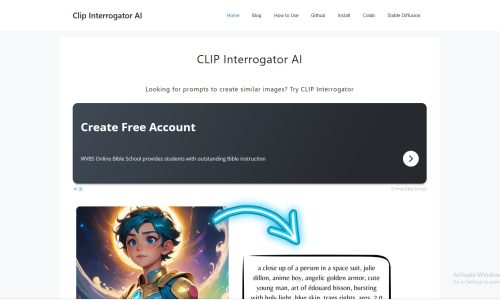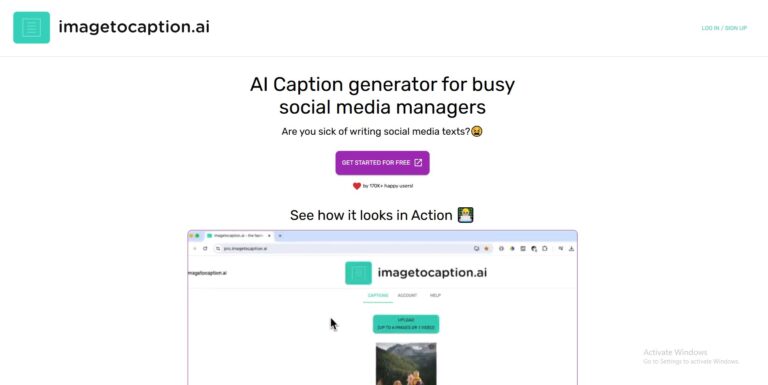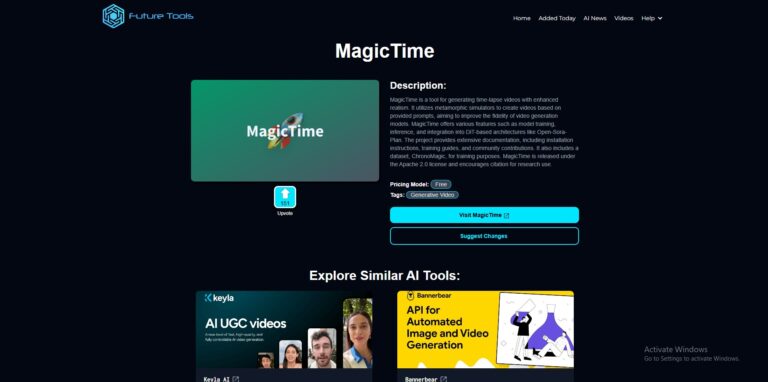The field of artificial intelligence is experiencing a growing need for tools to assist communication between images and text. This tool, Clip Interrogator, is a highly sophisticated AI service that analyses both visual content and generates a semantic description. The use of Openai’s CLIP abilities makes Clip Interrogator both an imaginative partner, research assistant, and messenger of images and words.
If your goal is to formulate rapid ideas for AI art, to delve into visual perception, or to receive metadata out of images as a digital creator, Clip Interrogator provides new perspectives on machine interpretation and text generation.
What Is Clip Interrogator?
Using Clip Interrogator, an image is passed into the system, which generates an output of a natural-language description or prompt according to what the image contains. Clustering based on Openai’s CLIP model, an AI to determines patterns between images and their textual descriptions. Clip Interrogator attempts to find the optimal prompt, which would generate the provided image. “What description is likely used by someone to make this image come to life in a generative model?”
Key Use Cases of Clip Interrogator
1. Prompt Engineering for AI Art
Choosing a good prompt for AI-generated art might not be something to can be easily done. Using Clip Interrogator, users can analyse finished art and reveal a text description that could be replicated. This iteration process for artists makes tweaking of prompts easier and more consistent.
2. Metadata Generation
Using Clip Interrogator, one can easily generate metadata tags for images, thus optimising the organisation of assets. This tool assists in the proper handling of large volumes of images, particularly handy in industries such as e-commerce, the graphic design industry, and academic archives, with no need for manual tagging.
3. Creative Writing and Storytelling
Writers can use Clip Interrogator as a starting point in creating image descriptions. The picture of a dramatic landscape can prompt an evocative or fantastic description, which can serve as a trigger that will stimulate the preparation of the short stories, poems, and narratives for games.
4. Accessibility and Image Alt Text
An effective service is generating alternative texts for images on websites to increase access. Although the tool isn’t always correct, Clip Interrogator offers useful descriptions that enhance the understanding of images for visually impaired users.
5. Academic Research and Machine Perception
Computer vision and multimodal AI researchers use Clip Interrogator as a benchmark to evaluate how AI interprets visual data. Through its use, researchers look into the biases, precision and representativeness of language, as produced by machines.
Advantages of the Clip Interrogator
High-Quality Descriptions
The descriptions often have strong insight into style, composition, emotional resonance and what the image conveys. In doing so, this demonstrates the powerful cross-modal learning from CLIP.
Useful for Reverse Prompting
Offering reverse prompt functionality, it is one of the most useful tools for Midjourney and Stable Diffusion, and other applications that require prompt-based inputs.
Open Source Options
Clip Interrogator provides several free-to-access versions and is available at sites like Hugging Face and GitHub. This allows for individualisation in both professional users and developers who need a customised solution.
Works Across Styles
This is true for a variety of styles, such as realistic, surreal, anime, and pixelated ones, where Clip Interrogator provides accurate and relevant context at all times.
Disadvantages and Limitations
Inaccuracy in complex scenes
Good with general subjects, it can misinterpret the busy or abstract scenes. Sometimes it can ignore small but important visual elements.
Bias in details
Since the underlying model (CLIP) was trained on internet data, production can reflect cultural or linguistic prejudice. This is a well-known concern in the AI community.
Not a real “fast generator”
It provides a descriptive phrase, not necessarily an ideal signal to generate the same image. Users often need to adjust and refine the output manually.
People are depending on data
The performance of the model is greatly affected by the training kit. There may be a lack of awareness of new cultural references, trends or top subjects.
Clip Interrogator in the Creative Ecosystem
The emergence of cutting-edge inquiries reflects a widespread trend in AI: the fusion of modelling. Instead of just working with text or images, AI now explains both and translates each other to another. This capacity opens the door to the intelligent search engine, automatic design tool and actual multimodal content production.
When AI art continues to achieve mainstream traction, tools that cut artists out of their creative process to understand and control their creative process. This is not just a tool – there is a mirror in the brain of the machine.
Conclusion
Cutting inquiries have a captivating and sensible tool in AI Panorama, especially for people who go at the intersection of artwork, language and time. By translating Pix into descriptive activism, it strengthens the creators, improves access and leads to our knowledge of the way machines understand visible information.
While the limitations are, the equipment reflects an essential step in the collaboration between humans. As visible AI grows, tools such as clip-thogats will play a significant role when it comes to making photography-based structures more transparent, controlled and creative-rich.




